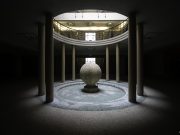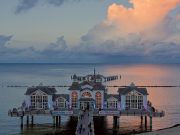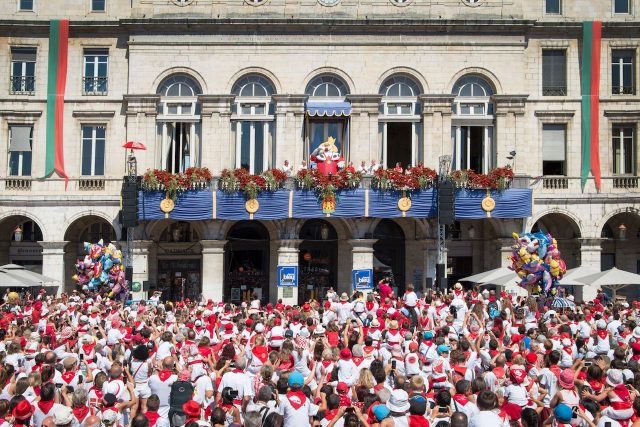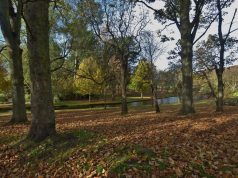
This annual event were only available in 1932 when a pair of friends from Bayonne joined the functional within the Bulls in Pamplona and made a decision to start up a similar event for their hometown. Eighty-six years later, Fêtes de Bayonne is France’s largest festival with thousands of festayres, or partygoers, wearing white and red comparable to their Pamplonan inspiration, descending around town.
The festival starts about the Wednesday prior to a first Sunday of August using the secrets of madrid being thrown through the balcony in the town hall to residents below. Next, the area is overtaken by 5 days and nights of partying, as well as the traditional courses de vaches, when festayres can volunteer to initiate an arena which includes a bull and dodge its charges.
Fortunately, less risky competitions arise over the festival, in the process. Some examples are a foot race from Biarritz to Bayonne, pelote Basque tournaments, and the Omelette aux Piments World Championships, during which contestants compete to get the most beneficial on the planet at using the region’s signature spice from a classic French dish.
2. Have a bet on pelote Basque.


Entering an aggressive pelote Basque tournament generally is a bit ambitious for first-timers, but that doesn’t mean you can’t love this particular fast-moving sport for a spectator. Just don’t expect you\’ll understand it immediately. Pelote Basque extends back on the 17th century, and more than earlier times 400 years, the towns and villages on the province are suffering from approximately 22 different variations with the game.
There are, however, several similarities to watch out for. With regards to the game itself, most versions of pelote Basque involve two teams hitting a ball, or pelote, against a wall having a woven basket tied to their wrists then it lands back into the court. Meanwhile, aesthetically, the clash of your traditional pelote Basque players — each team wearing white uniform pants which includes a single-colored shirt — around the province’s distinctive outdoor courts allow it to become very easy to spot any time a game has been played.
3. Surf waves at sunrise.


Pelote Basque and bull-running aren’t a common sports to experience put the French Basque Country on the map. Cornered by the raging swell from the Atlantic as well as snow-dusted mountains in the Pyrenees, geographically, the province was practically made for outdoor lovers. Surfers are already coming here since 1950s when Californian tourists first brought surfing to Biarritz. Madrid of Anglet has 11 beaches alone, earning it the nickname of “Little California,” and kiteboarders also find a lot of spots to whiz through the sea.
Biarritz currently is generally known as Europe’s historic surfing capital plus the sight of Quicksilver’s European headquarters. Some miles beyond Biarritz, technically north within the Cotes Basque, or Basque Coast, are definitely the beach breaks of Hossegor. Hossegor’s endless beach attracts surfers from around the world, and it is massive dunes perform the duties of excellent viewpoints to be upon the incredible surf scene.
4. Climb mountains at sunset.


Up out in the wild, Saint-Jean-Pied-de-Port in the Pyrenees is the starting place for the best popular route with the Camino de Santiago pilgrimage path. Hikers and bikers relish the forest that mark the western end on the French Basque Country, though the majority also come in summer. Away from peak months of July and August, you can find peaceful mountain trails throughout the Pays Basque. During spectacular hiking spots just like the Gorges d’Holzarté, it’s rare to meet up with another walker — which, after one consider the rope bridge throughout the canyon, you’ll probably agree is an effective thing.
5. Walk with the lighthouse on the Old Port in Biarritz.


Less taxing than hiking the Pyrenees, this walk across the iconic coastline of Biarritz is nonetheless quite as scenic. In 1843, Victor Hugo wrote of Biarritz, “I have never met worldwide anywhere you want to more pleasing and excellent,” and it’s obvious why. Starting within the lighthouse, which divides the sandy beaches of Landes from your rocky Basque country coast, the walk encompasses rugged cliff tops; the historic promenade; and also the Rocher en Vierge, a rock formation wherein a statue in the Virgin Mary overlooks panoramic views on the town.
Beyond taking in the sights, the route offers plenty to carry out. The Miremont Patisserie can be just as known for its view as things are for its pastries; the Port de Pêcheurs is how you’ll chose the town’s best and freshest seafood; and after the walk, at high tide, you may cool off by diving within the ocean along at the Plage du Port Vieux.
6. Have pleasure in the provincial flavor of piment d’espelette.


Whether it’s from our cuisine or maybe the festoons that hang out of available space outside to dry, you can’t go far while in the French Basque Country without coming across the province’s distinctive espelette pepper. Introduced through the 16th century, espelette chilli peppers were originally used medicinally and older time are getting to be so popular in the local cuisine they\’ve his or her festival.
Hosted through the Confrérie du piment d’Espelette, or Brotherhood of the Espelette Pepper, the Fête du Piment à Espelette occurs every October as an easy way of celebrating local producers as well as gastronomic culture within the region. It provides the indoctrination associated with a dozen local experts in cooking, media, entertainment, and sport to the brotherhood, as well as a religious mass through which the peppers are blessed.
7. Get back over time in Saint-Jean-de-Luz.


Just a number of miles north in the Spanish border sits Saint-Jean-de-Luz, a tiny seaside town that’s played a major role in French history. It was here, from the Saint-Jean-Baptiste Church, that Louis XIV of France married María Teresa of Spain in 1660, putting a finish to the bitter war. The main door into the church ended up being sealed off, representing a detailed towards troubles forwards and backwards nations.
Today, Saint-Jean-de-Luz one is the most planning to transport visitors time for its days as being a thriving fishing town than its days as the political epicentre. La Nuit de la Sardine, or Night of the Sardine, still happens twice throughout the summer whilst in July the Fête du Thon, or Festival of Tuna, sees tuna crowned the “King of Fish” — with restaurants serving it will always be griddled hot tuna steaks and music and dancing filling the streets. It’s an affection of food and culture that may generally placed into france Basque Country.
































